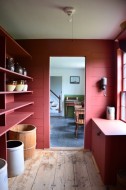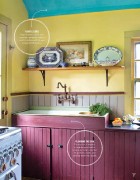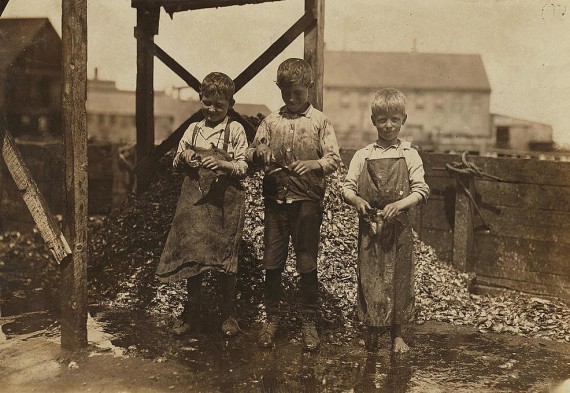
Goodbye Old House
May 19, 2020
Recently, while on the hunt for salvaged, wide plank, floor boards, we got a tip that a house on Hawkes Avenue in Eastport, that had languished for decades, was going to be torn down. We were familiar with the property because we considered it while house hunting in anticipation of our move Downeast. At that time the online real estate site boasted that the original owner and builder, a carpenter, had dressed the simple Victorian with a variety of impressive and unusual moldings inside and out- some quite elaborate for a modest home. Curious about the property, as we always are, we looked into it a bit to see what secrets it might give up. We couldn’t save the house but we could tell its story.
John Alexander Howard was born on his parent’s farm in Gagetown, New Brunswick in 1853. His childhood was spent learning the ins and outs of farming. His father was a Canadian born Scotsman, while his mother, born in Ireland, was likely a refugee of the Great Irish Famine. In 1883 John came to Eastport where he would take up carpentry. He was likely drawn to the bustling economy, with its attending opportunities, fueled by a burgeoning sardine industry. About this time the town sported 13 canning factories and a population of roughly 5,000. Concurrent with the year of his immigration he married Harriet (Hattie) Ann Barnes also a recent transplant from New Brunswick.
Sometime after the birth of their first child, Fred, in 1885, they set about to secure for themselves their very own home. In 1887 they purchased property from Isabella Anstice Hawkes the wife of a hotel owner and daughter-in-law of prominent and well-to-do, local physician, Micajah Hawkes. At the time this section of town was still mostly farm land with a few small buildings scattered along a rough dirt street. In August of 1888 an item appeared in the Eastport Sentinel; "Mr. John Howard is building a house for himself on the north side of Hawkes Avenue." John and Hattie would have two more children, Edith and Gladys, in their brand-new home.
We finally got our chance to visit 9 Hawkes Avenue this winter. It was bittersweet. It’s always sad to see an old building that’s stood the test of time for 130 some years come down. A simple 2 story, gabled, cape - it had classic dental moldings all around with a delicate carved fan in the gable. The front door sported stained glass and a canopy with lovely ornate brackets.
Inside we marveled at the unusual elegant moldings - different in every room and impossible to buy in a lumber yard today. The kitchen appeared as though it was redone in the 1940s. It resided in a small wing off the back that looked to be an earlier post and beam structure. This building may have already been on the property when it was purchased. We surmise that it could date to as early as 1830. Upstairs in the main house remains a wonderful curved corner tub in perfect condition. A large basin wall mounted sink dates the bathroom to 1939.
Though there were not the floorboards we’d hoped for, we set to the task of removing anything we could recycle. Eastlake hinges and window locks, 'Brown Betty' door knobs, cast iron escutcheons and keyhole covers. A depression era glass knob and walnut door stopper have already found their way to a current bathroom project. Hand cut dovetailed drawers with mahogany knobs, repurposed from 1840s casework to built-ins, will be repurposed again to our own master bedroom walk-in closet. 2 over 2 windows in excellent condition, from most of the first floor, are perfect for an enclosed porch we’ve been dreaming of and planning for many years.
On the 14th of June, 1905, John’s father, “Donald Ross Howard of Gagetown in the County of Queens and Province of New Brunswick, farmer,” put his ‘mark’ to his last will and testament. “First - I will and bequeath to Frank Montooth who is married to my grand-daughter my rifle. Secondly - I will and bequest to my granddaughter Ida Graham Howard my silver watch. Thirdly, I will and bequeath all the rest of my personal property to my beloved wife, Ann Howard. She to give my body decent burial and settle what small bills I may owe.”
Five month later a note appeared in the Eastport Sentinel, Nov. 8, 1905,"LOCAL NEWS: Mr. John A. Howard of this city was recently called to his former home in Gagetown, N.B., by the death of his parents, both of whom died within a few hours of each other. Mr. Howard returned to Eastport on Monday last."
This was followed by another note a week later. Nov. 15, 1905 "Two more of Eastport's well known and respected citizens have passed over to the Great Majority within the past week, John A. Howard and Wm. Camick, the latter's death occurring on Saturday last from a complication of diseases, his funeral taking place Monday afternoon; the former's on Monday night from pneumonia, contracted while attending the burial services of his parents, who recently died at Gagetown N.B. Mr. Howard's funeral will take place tomorrow, Thursday afternoon from the Christian church. Both of the deceased leave widows and families to mourn their departure from this life.”
Hattie would continue to live in the home until she sold the property in May of 1936 to Grayson Mitchell Forsyth and moved in with her daughter in Hollistown, Maine.
Grayson had grown up next door in a home that, rumor has it, was built by John Howard. His father, David. was an accountant, his mother, Lillia, a school teacher - later a nurse. In 1929 he married, 18 year old, Mary Lingley, the daughter of a lumber mill worker. They would have 4 children; Dorothy, Grayson, Richard and Mary Jean.
As a very young boy, Grayson worked as a cutter in the Seacoast Sardine Cannery. Many children from town and the surrounding area would work long hours under dangerous conditions in these factories sometimes suffering painful cuts - even losing fingers. As one of these children Grayson would distinguish himself in a compelling way, when at the tender age of 7, he became a subject of one of the iconic photographs of child labor reformer, Lewis Hine.
Lewis Wickes Hine was an American sociologist and photographer who in 1908 went to work for the National Child Labor Committee. For the next 15 years Hine took over 5,000 photographs of American children laboring in factories around the nation. His unprecedented efforts would aid the committee’s lobbying efforts to bring the practice to an end.
Hine's work was often dangerous. He was frequently threatened with violence or even death by factory police and foremen. At the time, the immorality of child labor was meant to be hidden from the public. Photography was not only prohibited but also posed a serious threat to the industry.[1] To gain entry to the mills, mines and factories, Hine was forced to assume many guises. At times he was a fire inspector, vendor, bible salesman, or even an industrial photographer making a record of factory machinery.[2]
In the end his compelling pictures helped to persuade legislators and the general public to support laws prohibiting child labor. The Fair Labor Standards Act of 1938 finally brought an end to the practice in the United States.
In 1911, Hine visited the sardine factories of Eastport, Maine. Joe Manning, architect of the “Lewis Hine Project”, surmised, ”On this summer day in Eastport, Grayson would have walked to work from his house at 11 Hawkes Avenue, probably heading east, turning right on High Street, and left on Pleasant Street. It would have taken him less than 10 minutes. Seacoast Cannery Factory #7 was on the southern end of the city, where Pleasant Street and Dawson Street meet on the edge of Passamaquoddy Bay.”
In a Manning interview for the project, Grayson’s son, Richard, described his father, who worked for much of his life for the Railway Express delivery company, “as strong as an ox. He was only about 5′ 6″. But you have to understand that these guys grew up tossing 400-pound barrels. He was all muscle. When my parents got married, they moved to Portland (Maine). My mother was thrilled to get out of Eastport. But then my father’s father got injured on the job and couldn’t work, so they had to go back and help out. Then the Depression came.
When I was very young, he bought a house nearby on the same street. The house was in terrible shape. He spent many years putting it back together again. He never really got to enjoy it. When you live by the ocean, the paint on your house never stops peeling, and you never stop painting. The house was decorated with more than a thousand little pieces of raised wood along the roof and all along the side. He painted each one of them individually. I said to him one day, ‘Why are you doing that?’ He said to me, ‘If I don’t do it, I’ll know that it is not the way it should be.’ I don’t know how he had the patience to do that. He lived in that house until he died.”
1. Murphy, Adrian (September 2019). "Children in the machine: Lewis Hine's photography and child labour reform". Europeana (CC By-SA). Retrieved September 27, 2019.
2. Rosenblum, Walter. Foreword. America & Lewis Hine: Photographs 1904–1940: Comp. Marvin Israel (1977). New York: Aperture, up. 9–15. Print.
Special thanks to Joe Manning for permission to use material from the Lewis Hine Project
Thanks to the Library of Congress for the Lewis Hine photographs
(click photo to view larger image)
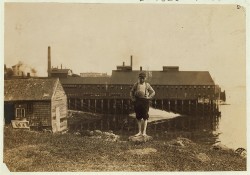
|
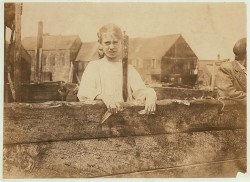
|
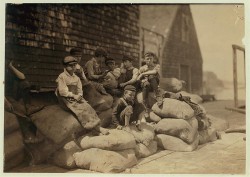
|
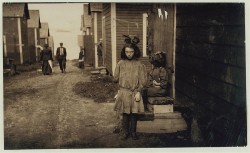
|
(comments = 3)
What a beautifully heartfelt reflection on saying goodbye to an old house. Your clear descriptions truly capture the emotional journey of leaving a beloved space filled with memories. It’s a reminder of how places shape our lives and the importance of embracing change.
Through your research we not only learn of the house but th he souls th hat inhabited them. I am living in a house buiit in 2006 and will never have the historical tie to the past in its architecture and details. I count on you to give me that joy through your pictures and articles.
This house was built by my great grandfather, John Alexander Howard. My husband and I toured it in 1998. My mother said there was a beautiful hand made secretary with a roll top he had made.
Grayson Forsythe's granddaughter sent me this article or I would never have known. Is there some small object that you removed that I could buy to remember the house by? As a souvenir the place where my mother was born, my great grandfather built? I'm overwhelmed just now to be more coherent. Thank you,
leave a comment

fineartistmade blog
A journal about home design, gardening, art & all things Maine. Read more...
- June 2025
- December 2022
- November 2022
- October 2022
- November 2021
- May 2020
- October 2019
- August 2019
- July 2019
- September 2018
- April 2018
- December 2017
- August 2017
- June 2017
- May 2017
- December 2016
- August 2016
- July 2016
- April 2016
- November 2015
- June 2015
- May 2015
- March 2015
- October 2014
- March 2014
- February 2014
- January 2014
- December 2013
- November 2013
- July 2013
- May 2013
- April 2013
- March 2013
- January 2013
- December 2012
- November 2012
- August 2012
- June 2012
- April 2012
- March 2012
- February 2012
- January 2012
- December 2011
- October 2011
- August 2011
- July 2011
- June 2011
- May 2011
- April 2011
- March 2011
- February 2011
- January 2011
- December 2010
- November 2010
- October 2010
- September 2010
- August 2010
- July 2010
- June 2010
- May 2010
- My Scandinavian Home
- Daytonian in Manhattan
- {frolic!}
- I Married An Irish Farmer
- Smitten Kitchen
- The Curated House
- even*cleveland
- Mary Swenson | a scrapbook
- Ill Seen, Ill Said
- Gross & Daley Photography
- Remodelista
- Abby Goes Design Scouting
- Mint
- the marion house book
- 3191 Miles Apart
- Svatava
- Katy Elliott
- Poppytalk
- Kiosk
- decor8
- KBCULTURE
- Lari Washburn


